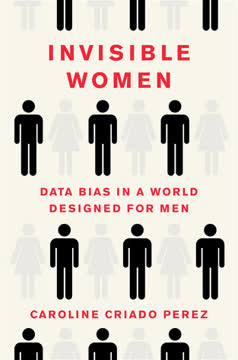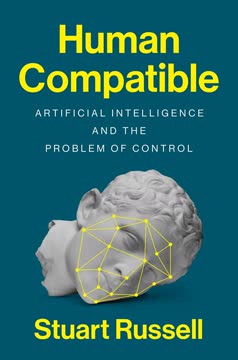Key Takeaways
1. AI algorithms simplify complex realities, often reinforcing biases
Algorithms must use frames with limited sets of concrete, symbolic atoms to represent things and concepts in the real world. And frames, by their nature, are brittle.
Simplification leads to bias. AI algorithms, by necessity, reduce complex realities into simplified models with limited sets of features or "atoms." This process of simplification often leads to the reinforcement of existing biases and stereotypes. For example:
- Google's image recognition system labeling black people as "gorillas"
- AI-powered job recruitment tools favoring male candidates
- Predictive policing algorithms disproportionately targeting minority neighborhoods
These biases arise not from malicious intent, but from the inherent limitations of algorithmic representations and the data they are trained on. The challenge lies in recognizing these limitations and working to mitigate their effects.
2. The evolution of AI: From symbolic reasoning to big data statistics
Expert systems, if asked a question even marginally outside the frame that their programmers had intended, fail, and fail rather dramatically, when compared to human experts.
From rules to data. The field of AI has undergone a significant transformation over the decades. Early approaches focused on symbolic reasoning and expert systems, attempting to codify human knowledge into rules and logical structures. However, these systems proved brittle and limited in their ability to handle real-world complexity.
The advent of big data and increased computational power led to a shift towards statistical approaches:
- Machine learning algorithms that learn patterns from vast amounts of data
- Deep learning neural networks capable of processing complex, unstructured information
- Natural language processing systems that can understand and generate human-like text
While these new approaches have achieved remarkable successes, they also introduce new challenges, particularly in terms of interpretability and the potential amplification of biases present in training data.
3. Probability theory in AI: Limitations and misconceptions
Shannon of course knew that messages being sent down electronic wires and processed by computer algorithms had to, at some point, be read and understood by people, so he went on to point out that his information was disconnected from meaning, as well.
Probability ≠ human uncertainty. The application of probability theory in AI often misses crucial aspects of human reasoning and decision-making. While probability theory provides a powerful framework for dealing with certain types of uncertainty, it falls short in capturing the full range of human cognitive processes.
Key limitations of probabilistic approaches in AI:
- Focus on "truth uncertainty" while neglecting semantic and ontological uncertainties
- Assumption that human decision-making follows rational, probabilistic rules
- Difficulty in accounting for context, emotions, and intuition in human reasoning
The "Linda Problem" illustrates these limitations, showing how human reasoning often prioritizes coherent narratives over strict probabilistic logic. AI systems built solely on probabilistic foundations may struggle to capture the nuanced, contextual nature of human thought.
4. The impact of AI on human communication and social networks
Algorithms do most of the economic work as well. Advertisers' algorithms can subscribe to demographic packages of consumers that are put together algorithmically. What content is delivered to which people is decided algorithmically.
Algorithmic mediation of human interaction. AI is fundamentally reshaping how we communicate and interact in digital spaces. Social media platforms, powered by sophisticated algorithms, are creating new dynamics in human relationships and information flow.
Effects of AI on communication:
- Filter bubbles and echo chambers reinforcing existing beliefs
- Algorithmic content curation prioritizing engagement over diversity of viewpoints
- Simplification of complex ideas to fit algorithmic preferences (e.g., SEO optimization)
- Rapid spread of misinformation and "fake news"
These changes pose significant challenges to social cohesion and democratic discourse. Understanding and mitigating these effects is crucial for maintaining healthy social interactions in the digital age.
5. Diversity and creativity: Essential for effective evolution and innovation
Diversity plays a key role at this 'edge of chaos'. In fact, it is the key to creative innovation, offering a multitude of solutions and options from which the engine of evolution can select in order to effectively adapt (rather than optimize) to changing environments and circumstances.
Diversity fuels innovation. Both biological evolution and human creativity thrive on the juxtaposition and recombination of diverse elements. This principle has important implications for AI and human systems alike.
In evolutionary algorithms and real-world systems:
- Diverse populations provide a rich pool of potential solutions
- Recombination of ideas leads to novel innovations
- Balancing selection pressure with diversity preservation is crucial
Examples of creative bisociation:
- Gutenberg's printing press (playing cards + wine press)
- Pasteur's immunology (vaccination + yeast fermentation)
- Darwin's theory of evolution (utopian ideas + Malthusian economics + variation)
Fostering diversity in AI systems and human organizations can lead to more robust, adaptable, and innovative outcomes.
6. The edge of chaos: Where complex systems thrive
Edge of chaos systems seem capable of generating structure that exceeds the algorithm's ability to capture that structure. Those systems are their own best model.
Complexity emerges at the boundary. The concept of the "edge of chaos" provides a powerful framework for understanding complex adaptive systems, including biological, social, and potentially AI systems.
Characteristics of edge of chaos systems:
- Balance between order and randomness
- Ability to maintain structure while adapting to change
- Emergence of complex, unpredictable behaviors
This concept challenges the notion of optimization towards a single "fittest" solution, suggesting instead that adaptive systems maintain a diversity of potential states. For AI development, this implies a need to move beyond simple optimization towards more flexible, context-aware systems capable of adapting to changing environments.
7. AI as a philosophical tool: Revealing what we aren't
AI isn't just a technical topic, it is a cultural crossroads. Correction: it should be. If enough people read this book, it will be. In Rage Inside the Machine, Robert Elliott Smith accomplishes what few people could attempt: to humanize the discourse on artificial intelligence.
AI as a mirror for humanity. The development of AI serves not only technological progress but also as a powerful philosophical tool for understanding human cognition and society. By attempting to recreate human-like intelligence, we inevitably confront the limitations of our models and gain new insights into the nature of human intelligence and consciousness.
AI research highlights:
- The complexity and context-dependence of human decision-making
- The role of embodiment and emotion in cognition
- The social and cultural aspects of intelligence
Rather than seeing AI as a potential replacement for human intelligence, we can view it as a means of exploring and appreciating the unique aspects of human cognition and creativity. This perspective encourages a more nuanced and humanistic approach to AI development and application.
Last updated:
Review Summary
Rage Inside the Machine receives mixed reviews, with an average rating of 3.99 out of 5. Readers appreciate Smith's expertise and insights on AI and algorithms, praising the book's depth and historical context. Many find it thought-provoking and relevant to today's technology-driven society. However, some criticize its heavy mathematical content, making it less accessible to general readers. The book is lauded for its exploration of bias in algorithms and their impact on society, though a few reviewers felt it could have offered more concrete solutions.
Similar Books










Download PDF
Download EPUB
.epub digital book format is ideal for reading ebooks on phones, tablets, and e-readers.




